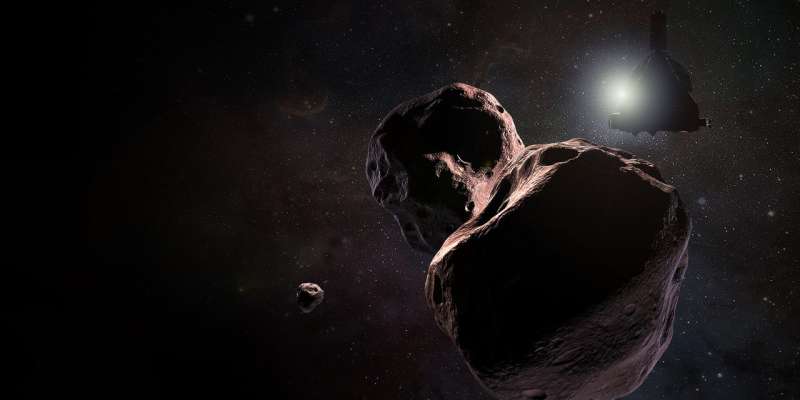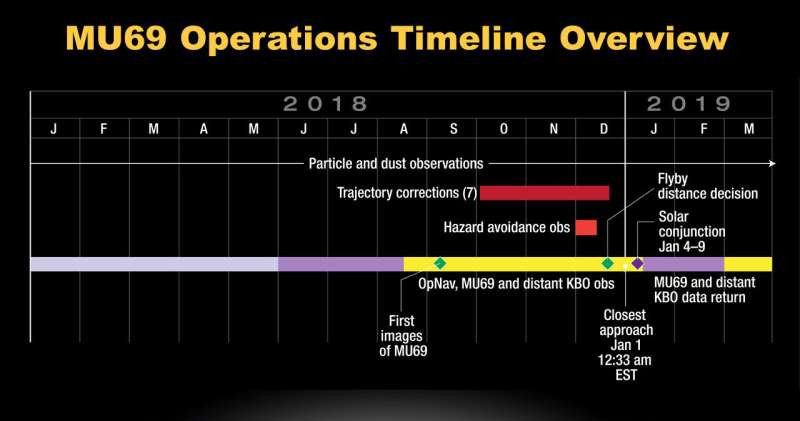Spend next New Year's eve with New Horizons

The New Year's celebration to usher in 2019 will include an event like no other – more than four billion miles from Earth.
In just under a year – shortly after midnight Eastern Time on Jan. 1, 2019 – NASA's New Horizons spacecraft will buzz by the most primitive and most distant object ever explored. New Horizons' encounter with Kuiper Belt object 2014 MU69, which orbits a billion miles beyond Pluto, will offer the first close-up up look at such a pristine building block of the solar system – and will be performed in a region of deep space that was practically unknown just a generation ago.
"The Voyagers and Pioneers flew through the Kuiper Belt at a time when we didn't know this region existed," said Jim Green, director of NASA's Planetary Science Division at Headquarters in Washington. "New Horizons is on the hunt to understand these objects, and we invite everyone to ring in the next year with the excitement of exploring the unknown."
"Our flyby of MU69 on New Year's Eve and New Year's Day 2019 will be an exciting sequel to the historic exploration New Horizons performed at Pluto in 2015," added Alan Stern, New Horizons principal investigator from Southwest Research Institute (SwRI) in Boulder, Colorado. "Nothing even like MU69 has ever been explored before."
As with the hundreds of thousands of other small worlds in this zone of icy bodies, MU69 is shrouded in mystery. In fact, the all we know about it has come from the Hubble Space Telescope (used to discover the object in 2014) and a comprehensive observation campaign last summer, in which the New Horizons team gathered data on MU69 as it passed in front of three stars. Those observations indicated that MU69 could be two objects, perhaps accompanied by a moon.

"That tells us this object is going to have a lot of surprises in store for New Horizons," said Marc Buie, the New Horizons science team member from SwRI who led the observation campaign. "We're going to see something that dates back to the formation of the solar system."
New Horizons will fly about three times closer to MU69 than it did to Pluto in July 2015, allowing the spacecraft's cameras to provide a more detailed look at the object's surface. Project Scientist Hal Weaver, of the Johns Hopkins Applied Physics Laboratory (APL) in Laurel, Maryland, pointed out that New Horizons' vantage point from about 2,175 miles (3,500 kilometers) from MU69 will allow it spot details about the size of a basketball court.
"Combining images with the measurements we make of the composition of and environment around MU69, should teach us a great deal about objects like MU69 that built dwarf planets like Pluto," Weaver said.
The MU69 flyby is the centerpiece of the current New Horizons extended mission that also includes observations of more than two-dozen other Kuiper Belt objects, as well as measurements of the plasma, gas and dust environment of the Kuiper Belt. "This post-Pluto mission is a complete and comprehensive exploration of the Kuiper Belt," said Alice Bowman, New Horizons mission operations manager, also from APL. "The spacecraft is collecting data out there throughout each year while the mission team works together to plan and shape the MU69 flyby."
New Horizons is currently in hibernation until June 4. After that wake-up and a check of the spacecraft's systems and science instruments, the MU69 encounter begins in mid- August, with the first attempts at long-distance observations of MU69 that the team will use to navigate the spacecraft along the flyby path.
Provided by NASA





















